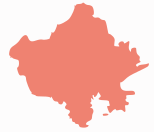Hanumangarh district | |
|---|---|
 Location of Hanumangarh district in Rajasthan | |
| Country | |
| State | Rajasthan |
| Division | Bikaner |
| Headquarters | Hanumangarh |
| Tehsils | Hanumangarh, Nohar, Bhadra, Pilibanga, Rawatsar, Tibi, Sangaria, Pallu.[1] |
| Government | |
| • District collector | Kana Ram[2] |
| Area | |
• Total | 9,656 km2 (3,728 sq mi) |
| Population (2011)[3] | |
• Total | 1,774,692 |
| • Density | 180/km2 (480/sq mi) |
| Demographics | |
| • Literacy | 67.13% |
| • Sex ratio | 960/1000 |
| Time zone | UTC+05:30 (IST) |
| Vehicle registration | RJ31, RJ49 |
| Major highways | National Highway 54 |
| Website | hanumangarh |
Hanumangarh district is a district in the state of Rajasthan in India. The city of Hanumangarh is the district headquarters and its largest city.
District profile
[edit]The district is located in the extreme north of Rajasthan. It has an area of 12,645 km2, a population of 1,774,692 (2011 census) and a population density of 184 persons/km2. It is bounded in the north by Punjab state, to the northeast by Haryana state, in the east and south by Churu District and in Bikaner District and on the west by Ganganagar District. The major livelihood of the district is farming; major crops include rice, millet, cotton, sonamukhi (senna), wheat, and vegetables. It was made a district on 12 July 1994 from Ganganagar district. Earlier it was one of the Tehsils of Sri Ganganagar district.[citation needed]
Hanumangarh also has Bhatner Fort which is considered to be one of the oldest forts of India.[4]
There are total eight ULB's or municipalities in Hanumangarh district. One municipal council in Hanumangarh city and seven municipal boards in Pilibanga, Sangaria, Nohar, Bhadra, Rawatsar, Tibbi and Goluwala.[citation needed]
Demographics
[edit]| Year | Pop. | ±% p.a. |
|---|---|---|
| 1901 | 59,161 | — |
| 1911 | 84,991 | +3.69% |
| 1921 | 70,360 | −1.87% |
| 1931 | 142,472 | +7.31% |
| 1941 | 220,233 | +4.45% |
| 1951 | 259,892 | +1.67% |
| 1961 | 432,522 | +5.23% |
| 1971 | 661,859 | +4.35% |
| 1981 | 945,807 | +3.63% |
| 1991 | 1,220,333 | +2.58% |
| 2001 | 1,518,005 | +2.21% |
| 2011 | 1,774,692 | +1.57% |
| source:[5] | ||
According to the 2011 census Hanumangarh district has a population of 1,774,692,[7] roughly equal to the nation of The Gambia[8] or the US state of Nebraska.[9] This gives it a ranking of 269th in India (out of a total of 640).[7] Hanumangarh is one of the highest per capita income earning district in India.
The district has a population density of 184 inhabitants per square kilometre (480/sq mi).[7] Its population growth rate over the decade 2001–2011 was 17.24%.[7] Hanumangarh has a sex ratio of 906 females for every 1000 males and a literacy rate of 68.37%. 19.75% of the population lives in urban areas. Scheduled Castes and Scheduled Tribes make up 27.85% and 0.81% of the population respectively.[7]
Languages
[edit]At the time of the 2011 census, 59.48% of the population spoke Rajasthani, 17.97% Punjabi, 12.87% Bagri, 6.59% Hindi and 0.94% Marwari as their first language.[10]
Punjabi language
[edit]Punjabi is spoken by 18% of district population. Punjabi has its ground as first language specially in the northern areas like Sangaria, Hanumangarh, Pilibanga tehsils. Punjabi is taught as a third language in many schools and also chosen by students up to postgraduate level. The Malwayi dialect is most common dialect of Punjabi language spoken. Other languages are Saraiki spoken by Arora Hindu and Rai Sikh communities who migrated from Pakistan after Partition.[11][12]
Places of interest
[edit]Air pollution
[edit]According to the World Air Quality Report 2024, Hanumangarh is one of the world's 20 most polluted city in India.[13]
References
[edit]- ^ "Tehsils in Hanumangarh District, Rajasthan". Population Census Data. 2022. Retrieved 24 August 2024.
1.Hanumangarh, 2.Nohar, 3.Bhadra, 4.Pilibanga, 5.Rawatsar, 6.Tibi, 7.Sangaria
- ^ "पोर्टल, राजस्थान सरकार". Hanumangarh, Government of Rajasthan (in Hindi). Retrieved 30 December 2024.
- ^ "Name Census 2011, Rajasthan data" (PDF). censusindia.gov.in. 2012. Retrieved 28 February 2012.
- ^ "Hanumangarh | India". Encyclopædia Britannica. Retrieved 11 November 2016.
- ^ Decadal Variation In Population Since 1901
- ^ "Table C-01 Population by religious community: Rajasthan". censusindia.gov.in. Registrar General and Census Commissioner of India.
- ^ a b c d e "District Census Handbook: Hanumangarh" (PDF). censusindia.gov.in. Registrar General and Census Commissioner of India. 2011.
- ^ US Directorate of Intelligence. "Country Comparison:Population". Archived from the original on 13 June 2007. Retrieved 1 October 2011.
Gambia, The 1,797,860 July 2011 est.
- ^ "2010 Resident Population Data". U. S. Census Bureau. Archived from the original on 27 December 2010. Retrieved 30 September 2011.
Nebraska 1,826,341
- ^ a b "Table C-16 Population by Mother Tongue: Rajasthan". www.censusindia.gov.in. Registrar General and Census Commissioner of India.
- ^ M. Paul Lewis, ed. (2009). "Bagri: A language of India". Ethnologue: Languages of the World (16th ed.). Dallas, Texas: SIL International. Retrieved 28 September 2011.
- ^ Lakhan Gusain 2000. Bagri. (Languages of the World/Materials, 384). Munich: Lincom Europa ISBN 389586398X
- ^ Mohan, Vishwa (12 March 2025). "With 13 of 20 most polluted cities, India ranks 5th globally". The Times of India. ISSN 0971-8257. Retrieved 18 March 2025.


